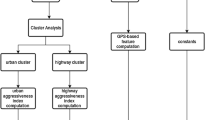Abstract
Car insurance companies have started to collect high-frequency GPS location data of their car drivers. This data provides detailed information about the driving habits and driving styles of individual car drivers. We illustrate how this data can be analyzed using techniques from pattern recognition and machine learning. In particular, we describe how driving styles can be categorized so that they can be used for a regression analysis in car insurance pricing.









Similar content being viewed by others
References
Breiman L, Friedman JH, Olshen RA, Stone CJ (1984) Classification and regression trees. Wadsworth Statistics/Probability Series, Chapman and Hall/CRC, Boca Raton
Hastie T, Tibshirani R, Friedman J (2009) The elements of statistical learning. Data mining, inference, and prediction, 2nd edn. Springer Series in Statistics, Springer, New York
James G, Witten D, Hastie T, Tibshirani R (2013) An introduction to statistical learning with Applications in R. Springer Texts in Statistics, vol. 103, Springer, New York
Verbelen R, Antonio K, Claeskens G (2016) Unraveling the predictive power of telematics data in car insurance pricing. KU Leuven-Faculty of Economics and Business. Available at SSRN: https://ssrn.com/abstract=2872112. doi:10.2139/ssrn.2872112
Weidner W, Transchel FWG, Weidner R (2016) Classification of scale-sensitive telematic observables for riskindividual pricing. Eur Actuar J 6(1):3–24
Wüthrich MV, Buser C (2016) Data analytics for non-life insurance pricing. Swiss Finance Institute Research Paper No. 16-68. Available at SSRN: https://ssrn.com/abstract=2870308
Author information
Authors and Affiliations
Corresponding author
Rights and permissions
About this article
Cite this article
Wüthrich, M.V. Covariate selection from telematics car driving data. Eur. Actuar. J. 7, 89–108 (2017). https://doi.org/10.1007/s13385-017-0149-z
Received:
Accepted:
Published:
Issue Date:
DOI: https://doi.org/10.1007/s13385-017-0149-z




